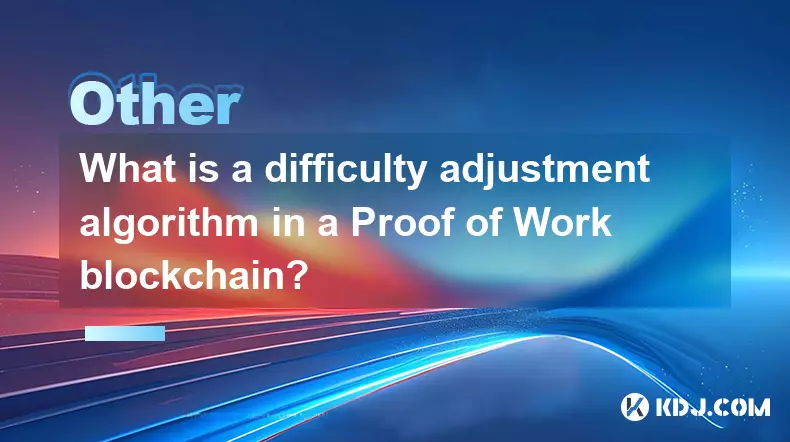-
 bitcoin
bitcoin $95203.028270 USD
-4.12% -
 ethereum
ethereum $3151.730711 USD
-1.61% -
 tether
tether $0.999170 USD
-0.04% -
 xrp
xrp $2.273039 USD
-1.55% -
 bnb
bnb $924.288432 USD
0.14% -
 solana
solana $141.112899 USD
-2.02% -
 usd-coin
usd-coin $0.999964 USD
0.02% -
 tron
tron $0.293976 USD
0.82% -
 dogecoin
dogecoin $0.160772 USD
-1.84% -
 cardano
cardano $0.506357 USD
-3.90% -
 hyperliquid
hyperliquid $37.900515 USD
0.03% -
 zcash
zcash $644.358451 USD
26.66% -
 chainlink
chainlink $14.062007 USD
-2.60% -
 bitcoin-cash
bitcoin-cash $484.381072 USD
-5.12% -
 unus-sed-leo
unus-sed-leo $9.199874 USD
0.27%
What is a difficulty adjustment algorithm in a Proof of Work blockchain?
Difficulty adjustment in Proof of Work ensures consistent block times by automatically scaling mining difficulty, maintaining network stability and security despite fluctuating hash power.
Nov 09, 2025 at 08:20 am

Understanding the Role of Difficulty Adjustment in Proof of Work
1. A difficulty adjustment algorithm is a core mechanism in Proof of Work (PoW) blockchains that ensures blocks are mined at consistent intervals despite fluctuating network hash power. Without such a system, mining times would vary wildly as more miners join or leave the network.
2. The primary goal is to maintain a stable block production rate. For example, Bitcoin targets one block every ten minutes. If miners solve puzzles too quickly, the network automatically increases the mining difficulty to slow things down.
3. Conversely, if the time between blocks grows too long due to reduced hash power, the algorithm reduces the difficulty to keep the pace steady. This self-regulating feature preserves the predictability and security of the blockchain’s transaction timeline.
4. Difficulty adjustments occur at predefined intervals. In Bitcoin, this happens every 2016 blocks, roughly every two weeks. The algorithm evaluates how long it took to mine the previous set of blocks and recalibrates accordingly.
5. The mathematical formula compares actual block times against expected times. If blocks were mined faster than ten minutes on average, the new difficulty will rise proportionally. If slower, it drops. This keeps the blockchain resilient against external shifts in computational power.
How the Algorithm Maintains Network Stability
1. The consistency enforced by the difficulty adjustment prevents congestion and delays in transaction confirmations. Users can rely on predictable confirmation windows because the network adapts to changes in processing capacity.
2. Sudden spikes in mining activity—such as when large mining farms come online—could flood the network with blocks. The algorithm counters this by raising the bar for what constitutes a valid solution, restoring balance.
3. During periods of declining interest or increased electricity costs, miners may shut down operations. The drop in competition could delay block creation, but the algorithm responds by lowering difficulty, ensuring continuity.
4. This dynamic response protects against centralization risks. If difficulty remained fixed, only well-resourced miners could sustain operations during high-competition phases, pushing out smaller participants. Adjustments help level the playing field over time.
5. The transparency of the rule-based system fosters trust. Every node independently verifies the correctness of each difficulty change, reinforcing decentralization and reducing reliance on centralized oversight.
Examples of Difficulty Adjustment Across Blockchains
1. Bitcoin uses an algorithm that adjusts difficulty every 2016 blocks based on the total time taken to mine those blocks. If that period is shorter than two weeks, difficulty increases; if longer, it decreases.
2. Litecoin follows a similar model but with faster block times—2.5 minutes—requiring more frequent adjustments to maintain precision in its mining schedule.
3. Ethereum, before transitioning to Proof of Stake, used a variant called “difficulty bomb” alongside regular adjustments to incentivize the move away from mining. The bomb gradually made mining harder over time regardless of hash power.
4. Some altcoins implement continuous difficulty adjustment, recalculating after every single block. This approach minimizes variance and provides tighter control over block intervals.
5. Monero employs a unique rolling average method, calculating difficulty using the median of the last 60 blocks. This resists manipulation attempts and stabilizes mining even under volatile conditions.
Frequently Asked Questions
What happens if no difficulty adjustment existed?Without difficulty adjustment, block times would become erratic. Increased mining power would lead to rapid block creation, potentially overwhelming nodes. Reduced power would cause long delays, making transactions unreliable and harming user experience.
Can difficulty adjustments prevent 51% attacks?While not designed specifically for attack prevention, difficulty adjustments indirectly influence security. After a sudden drop in hash power, lower difficulty could make attacks cheaper. However, honest nodes continuing to validate protect the chain's integrity through consensus rules.
Who controls the difficulty adjustment parameters?No individual or group controls it. The algorithm is hardcoded into the protocol. Changes require broad consensus among developers, miners, and node operators, typically achieved through soft or hard forks approved by the community.
Is difficulty adjustment unique to cryptocurrency?The concept isn’t exclusive to crypto, but its implementation in PoW blockchains is distinctive. Other systems may regulate workload, but the decentralized, automated, and transparent nature of blockchain difficulty adjustment sets it apart from traditional computing models.
Disclaimer:info@kdj.com
The information provided is not trading advice. kdj.com does not assume any responsibility for any investments made based on the information provided in this article. Cryptocurrencies are highly volatile and it is highly recommended that you invest with caution after thorough research!
If you believe that the content used on this website infringes your copyright, please contact us immediately (info@kdj.com) and we will delete it promptly.
- Decoding the Crypto Crystal Ball: Will Apeing Outpace XRP and BNB in 2025?
- 2025-11-15 12:25:02
- HBAR, Zero Knowledge, and the Privacy Revolution: What's the Smart Money Doing?
- 2025-11-15 11:40:02
- Crypto Presales Face-Off: Is Digitap ($TAP) Really Toppling BlockDAG?
- 2025-11-15 11:35:01
- Tokenization, 24/7 Markets, and Vlad Tenev: The Future of Finance?
- 2025-11-15 11:30:01
- Bull Market Bonanza: Crypto Presales and Explosive Growth Opportunities
- 2025-11-15 11:25:01
- Crypto Carnage: Navigating Selling and Liquidations in a Wild Market
- 2025-11-14 16:50:01
Related knowledge

What is the difference between a blockchain and a distributed ledger technology (DLT)?
Nov 14,2025 at 08:59pm
Understanding the Core Structure of Blockchain and DLT1. A blockchain is a specific type of distributed ledger technology that organizes data into blo...

How does a blockchain handle data storage?
Nov 14,2025 at 04:40pm
Understanding Blockchain Data Structure1. A blockchain stores data in sequential blocks, each containing a list of transactions or records. These bloc...

What are the risks of investing in blockchain projects?
Nov 14,2025 at 10:19am
Risks Associated with Volatility in Cryptocurrency Markets1. The price of digital assets can shift dramatically within minutes due to speculation, new...

What is the role of blockchain in creating a circular economy?
Nov 15,2025 at 02:19am
Enhancing Transparency in Supply Chains1. Blockchain technology provides an immutable ledger that records every transaction across supply chains, ensu...

How can blockchain technology be used in healthcare?
Nov 14,2025 at 07:39pm
Secure Patient Data Management1. Blockchain enables decentralized storage of medical records, ensuring patients maintain control over who accesses the...

How does blockchain impact the future of voting systems?
Nov 14,2025 at 10:00pm
Enhanced Security in Digital Voting Through Blockchain1. Blockchain technology introduces cryptographic hashing that ensures each vote is immutable on...

What is the difference between a blockchain and a distributed ledger technology (DLT)?
Nov 14,2025 at 08:59pm
Understanding the Core Structure of Blockchain and DLT1. A blockchain is a specific type of distributed ledger technology that organizes data into blo...

How does a blockchain handle data storage?
Nov 14,2025 at 04:40pm
Understanding Blockchain Data Structure1. A blockchain stores data in sequential blocks, each containing a list of transactions or records. These bloc...

What are the risks of investing in blockchain projects?
Nov 14,2025 at 10:19am
Risks Associated with Volatility in Cryptocurrency Markets1. The price of digital assets can shift dramatically within minutes due to speculation, new...

What is the role of blockchain in creating a circular economy?
Nov 15,2025 at 02:19am
Enhancing Transparency in Supply Chains1. Blockchain technology provides an immutable ledger that records every transaction across supply chains, ensu...

How can blockchain technology be used in healthcare?
Nov 14,2025 at 07:39pm
Secure Patient Data Management1. Blockchain enables decentralized storage of medical records, ensuring patients maintain control over who accesses the...

How does blockchain impact the future of voting systems?
Nov 14,2025 at 10:00pm
Enhanced Security in Digital Voting Through Blockchain1. Blockchain technology introduces cryptographic hashing that ensures each vote is immutable on...
See all articles









































































